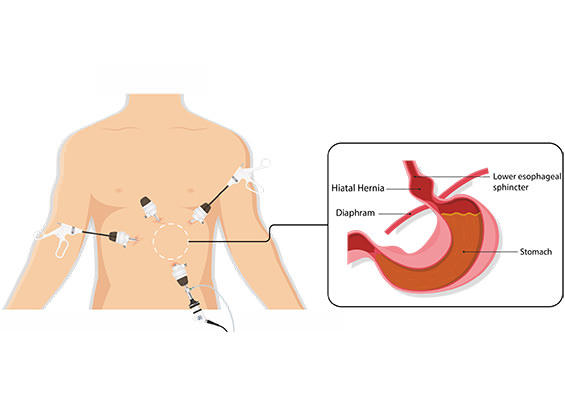Reflux Surgery
Laparoscopic Fundoplication/Hiatal Hernia Repair
Laparoscopic fundoplication with or without hiatal hernia repair is an operation which is performed to improve symptoms of reflux. It involves operating around the junction of the oesophagus (food pipe) and upper stomach to improve the function of the lower oesophagus sphincter (valve). If a hiatal hernia (protrusion of stomach into the chest) is present it will be reduced into the abdomen. A fundoplication involves wrapping the fundus (part of the stomach) around the oesophagus to help prevent reflux.
Indications
- Treatment of reflux or regurgitation
- Presence of hiatal hernia
- Evidence of bleeding or dysphagia secondary to hiatal hernia
Surgery
Fundoplication and hiatal hernia repair are typically performed laparoscopically. Surgery involves dissection of the oesophageal hiatus (where the oesophagus passes through the diaphragm). Occasionally a hiatal hernia will be present and need to be repaired at the time of surgery. The oesophagus is mobilised to allow 4-5cm of abdominal oesophagus. The stomach is then wrapped around the oesophagus (fundoplication). A fundoplication can be performed in 3 ways:
- Anterior (Dor) 180 degree wrap
- Posterior (Toupet) 270 degree wrap
- 360 degree (Nissen) wrap

Risks
Occasionally patients can have difficulty swallowing following surgery. Further procedures may be necessary. Following surgery, a modified diet will be implemented with progression from liquids to solid foods over 4-6 weeks.
Laparoscopic Heller’s Myotomy
Laparoscopic Heller’s Myotomy is an operation used to treat a condition called Achalasia. Achalasia is a condition that affects the oesophagus and the lower oesophagus sphincter (LOS). If you have Achalasia, your lower oesophageal sphincter fails to open up during swallowing. This leads to a backup of food within the oesophagus. Patients usually present with difficulty eating both solid and liquid foods.
Indications
Achalasia is the indication for a Heller’s Myotomy.
Surgery
Heller’s myotomy will typically be performed laparoscopically. Surgical instruments will be introduced to assist in performing the myotomy. A myotomy (dividing the muscle of the lower oesophageal sphincter) will be performed. Following the myotomy a fundoplication (Wrap of stomach) will be performed to prevent reflux in the future. Your surgeon will close the small cuts with sutures. Surgery typically involves admission for 1-2 days.
Risks
May include:
- Pain
- Bleeding
- Damage to surrounding structures including the oesophagus, spleen or vagus nerves.


